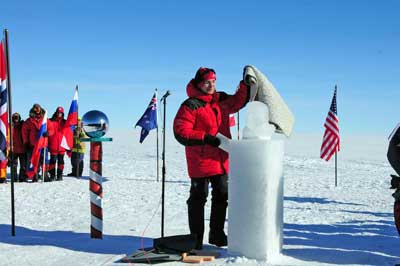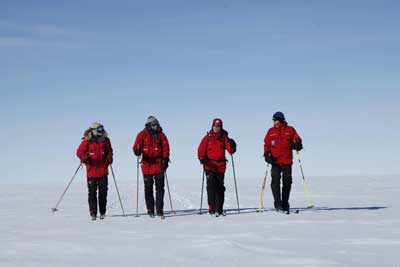|
Below...my documentation of the ventures that traveled to Pole in the centennial season of 2011-12...100 years since Amundsen and Scott showed up without an audience.
- Amazingly, there were races, so let's start with a couple of them:
-
- The Race to the South Pole
- managed by London-based Extreme World Races (EWR) was the successor event to the Amundsen Omega 3 South Pole Race, which was a great success in 2009-10. The 100th year anniversary race in 2011-12 had eight three-member teams booked (seven participated), mostly from the UK. The race started south of Novo from which it was based. After acclimatization and training at Novo, teams were flown to the starting point from where they traveled 500 miles to Pole in 30-45 days--two 250-mile legs with an enforced 24-hour rest stop between them--the bottom of this archived page describes the race plan, with links to other information, and this ExploraPoles page gives more information and lists the teams. One of the seven teams was Team SladenWoods,
Marc Woods and James Mark .Marc, who lost a leg to cancer, originally was part of the cancelled 2012 Inspire expedition. The teams started arriving in late December...they were taken to the start line by 3 January, and the event officially kicked off on 4 January. The teams arrived at Pole between 21 and 28 January. The bottom of this archived page gives some of the race results and follow-up. Marc did not finish due to pneumonia, per this Bournemouth Daily Echo article.
- The Scott-Amundsen Centenary Race (archived blog page from Henry Worsley and Lou Rudd's 10 January arrival)
- was a British venture that put two 3-man British Army teams on the ice to duplicate Amundsen's and Scott's Pole routes simultaneously! Yes...one team started from Cape Evans, and the other team started from the Bay of Whales site. They were supported at the start out of Union Glacier, but the treks themselves were to be unsupported. The teams...Henry Worsley led Amundsen's route (he led the Shackleton Centenary Expedition to Pole in 2008-09). His team members were Lennie Browne and Lou Rudd. Mark Langridge was leading the team on Scott's route...he had done a solo/unsupported Pole journey in 2008-09. His other team members were Vic Vicary and Kev Johnson. This was a significant venture to watch, since the routes up the Beardmore (Scott's route) and Axel Heiberg glaciers (Amundsen's route) have not been frequently traveled. The teams were flown to their starting points on 3 November and set out the next day, but Lennie Browne of the Amundsen team had to withdraw on 5 November...he was to be picked up and flown back to Union Glacier. Meanwhile, the Scott team went from Cape Evans to McMurdo, where they toured Scott's hut before heading south across the Ross Ice Shelf. As of 11 December both teams were close to their respective glacier climbs to the plateau--the Axel Heiberg and the Beardmore. The Amundsen team arrived on 10 January, the Scott team arrived in the evening of the 17th.
- More trips up the Axel Heiberg glacier:
-
 South Pole 1911-2011 (the archived English language site of Sørpolen 2011), was the Norwegians... South Pole 1911-2011 (the archived English language site of Sørpolen 2011), was the Norwegians...
- Vegard Ulvang, Jan-Gunnar Winther, Harald Dag Jølle, and Stein P. Aasheim, who planned a trip duplicating Amundsen's route up the Axel Heiberg glacier. They also planned to match his arrival date at Pole on 14 December. Here's an October 2011 NRK press release (in Norwegian). This event was supported by the Norwegian Polar Institute as part of their Nansen-American Year commemoration. They arrived at Union Glacier on 29 October, were flown to their starting point about 25 miles south of the original Framheim location on the 31st, and headed out the next day. As of 11 December they were at 88°50'S, not far to go...the Twin Otter that flew Asle Johansen of the Nansen to Amundsen expedition to Pole (next listing) passed overhead, landed and picked up some of their gear to lighten their loads. Later, an aircraft returned on the 13th and picked up Jan-Gunnar Winther and Stein Aasheim to get them to Pole in time for the ceremony (which is depicted at right, from this blog post); Vegard and Harald continued the ski trip...arriving at Pole at 2330 SP time on the 14th. The photo at right is from this archived blog post.
- To the South Pole 100 years later (the Nansen to Amundsen Expedition) (archived Norwegian language site)
- was a trip led by physician Asle T. Johansen, along with Agnar Berg and Gaute Grindhaug. They also started on the Ross Ice Shelf and headed to Pole via Amundsen's route up the Axel Heiberg Glacier...using replicas of Amundsen's equipment and clothing (!) (but not the dogs). The trip intended to commemorate the centenary of Amundsen's trip...in 1988 Asle had led three others on a trans-Greenland trek, duplicating Nansen's similar trip 100 years earlier, and also using authentic replica equipment. They were being resupplied. They started on 17 November, As of 2 December they were at 85.73°S, and had just met up with members of the Jubilee Expedition (next link). And on 11 December Asle aborted the trip and was flown to Pole to be present for the centennial, while Agnar and Gaute completed the journey overland.
- The South Pole Jubilee Expedition
- (archived expedition blog in English on Børge Ousland's site) was a large mostly-Norwegian unassisted/unsupported venture being guided by Christian Eide and Trond Sundby...the Norwegian participants were Theodor Johansen (age 19!) (archived October 2011 dittOslo article), Silje Molid, Gørild Hustad, Linn Elise Rølvåg, Jacob Meland, and Ottar Haldorsen, along with Rory O'Connor (expedition blog archive) from the UK. Correne Erasmus-Coetzer from South Africa, the Explorersweb correspondent, was originally part of this group but she joined the Børge trip described below instead--Correne was the first African woman to traverse to Pole, in January 2007. Also involved originally were Russians Victor Bobok and Igor Grishkov. who opted to travel independently from the Norwegians. The main group started at the south end of the Ross Ice Shelf and headed up the Axel Heiberg Glacier, but their departure from Union Glacier was delayed by weather and aircraft issues. (Børge (archived site) was also involved in the planning, but he was guiding the Last Degree venture discussed below, not this one.) They finally were flown to the starting point on 24 and 25 November and reached the top of the glacier on the 30th. On 14 December they were still 138 km from Pole, they figured this would take them 8-9 more days. They actually arrived on the 19th...and after staying a few days they split up. Trond, Linn Elise, and Ottar headed for home...Ottar had severe frostbite which got infected, he ended up being hospitalized in France. Jacob returned to Union Glacier to prepare for an attempt on Vinson. Meanwhile, the two Russians Victor Bobok and Igor Grishkov, frustrated by the delays, decided to make their venture independently...they were dropped off 250 km from Pole on about 27 November, and arrived at Pole on the 14th just in time for the ceremonies. Here is an advance ExploraPoles page about the venture plans...and ExploraPoles' links to all expedition coverage after it was successful.
- Jacob Meland and Ottar Haldorsen (archived site)
- two of the Jubilee Expedition participants, had this web site in Norwegian...here's a 30 April 2011 Helgeland Arbeiderblad (Mosjøen, Norway) article (in Norwegian) from 30 April 2011 which outlined their plans.
- Trips from the "Messner Start" (82°10'S-65°W on the Ronne Ice Shelf; this route was pioneered by Reinhold Messner and Arved Fuchs in 1989-90)
-
- Erling Rosenstrom
- guided an expedition sponsored by the Norwegian outfitter Hvitserk...guiding 5 other men...Kjell Vingen, Arve Husby, Eivind Prytz Rynning, Per Gunnar Jevne, and Tore Ovstebo on an unassisted/unsupported trek to Pole from the Messner Start...they were dropped off on 1 November. As of 14 December they'd made it to 87.5°S, they reached Pole on the 26th SP time.
- Howard Fairbank
- a South African adventurer, planned to leave in late November for a solo trip to Pole from the Messner Start...he was airlifted to the starting point on 21 November. He originally planned to return to Hercules Inlet with Richard Weber's group, using kites. As of 1 December he was at 84°14'S and having to repair breaking ski poles...he reached Pole on 28 December and then opted not to return north with Weber.
- Polar Vision (archived site)
- was a 3-man British-American team led by Alan Lock...whose vision has deteriorated badly from macular dystrophy, a disease that can gradually lead to total blindness. Still, he's put together the rest of what was originally a 5-man team--Richard Smith and Andrew Jensen, for a 2011-12 trip to Pole. Guided by Hannah McKeand, they will be following the 600-mile Messner route, with two resupplies. Alan's venture was featured in a 21 October New York Times article. They were flown to their starting point on 26 November and were making good progress, as of 2 December they were about 20% of the way, 439 miles to go. They reached Pole on 4 January.
- Richard Weber (archived link to his January blog with links to earlier posts/pages)
- the experienced Canadian guide, led four folks on a 35-day expedition from the Messner Start on the Filchner Ice Shelf to Pole...Kiwi Michael Archer, Chris De Lapuente, American Kathy Braegger, and British/American Ruth Storm (USA/UK). They flew from Union Glacier to their starting point on 22 November, but on the 27th Kathy was very ill...and medevaced back to Punta Arenas. Kathy's (aborted) blog was at southpoleroundtrip.com. On 1 December they'd passed 83°S. Richard fell at some point in mid-December and severely injured his left wrist, right knee and calf. He was flown back to Union Glacier on the 23rd, thence to a hospital in PA where, fortunately, his injuries turned out to not be long term. Richard and Michael reached Pole on 30 December SP time, from there they planned to kite/ski back to Hercules Inlet...as of 3 January they were still waiting for favorable wind conditions. They left Pole a couple of days later and completed the trip to Hercules Inlet on the 17th.
- Trips starting from Hercules Inlet/Union Glacier:
-
- Cas and Jonesy (archived site)
- is Australians James Castrission and Justin Jones, they planned what they claimed would be the first unsupported round trip from the coast (Hercules Inlet) to Pole in 2011-12. Among other previous adventures, they kayaked across "the ditch" between Australia and NZ in 2007-08. They were on the first flight to Union Glacier on 29 October and started from Hercules Inlet on the 31st. After a slow start due to soft conditions, their pace has improved, although they've recently developed some pains and strains, and Cas was suffering from a groin skin infection. As of 2 December they'd reached about 83.4°S. they arrived at Pole on New Years Day, staying only a few hours before heading north, a race against time to get back to Hercules Inlet before the season ends. After struggling on short rations, they reached HI on 27 January (well, still Australia Day--the 26th in their time zone). Oh...here is their current website.
- Mark George (archived site)
- an Australian financial advisor and Everest summiter, proposed a 2011-12 solo unassisted trip to Pole from Hercules Inlet, using a kite on the return trip. After the usual delays, he was finally dropped off at his starting point on 27 November, and he was making fair progress with loud music on his Ipod. On 2 December he was at almost 81°S. Here is an archive of his older main web site. He reached Pole on 9 January...and contemplated continuing for a few days, but there were no suitable winds for kiting so he planned to fly back to UG.
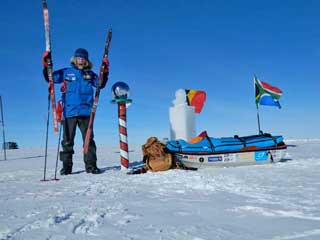 Aleksander Gamme Aleksander Gamme
- was yet another Norwegian hoping to make it to Pole from Hercules Inlet in time for the Amundsen centennial...only the first half of what he hopes to be the first solo unsupported round trip from the coast without using kites. He hoped to take advantage of the extended flight season to pull off what may be a 100-day trip. He was on the delayed first passenger flight to Union Glacier on 29 October and set off almost immediately. He reached Pole on the 26th and quickly turned back north. He reached Hercules Inlet on the 25th, although he waited until the 27th to join Cas and Jonesy for the final kilometer of the route. There is very little archived from his website, but this page (source of the photo at right) shows his arrival at Pole. Here is his Wikipedia entry.
- Aborted! Steffen Dahl
- was yet another Norwegian who planned a solo unsupported/unassisted trip to Pole from Hercules Inlet. He was supposed to be on the second ANI/ALE flight to Union Glacier on 22 October, but as of 28 October he was still in PA. He finally reached his HE starting point on 30 October...but after slow going, on 11 November, at about 80°S, he opted to hitch a ride on an ALE vehicle that was heading to a Thiel Mountains fuel depot, where he was dropped off at 85°S on 16 November and set out again. As of 28 November he was at 87°35'S, on 1 December he was near 88°S, but he had become ill, and radioed for pickup due to medical problems. The ALE aircraft that picked him up on 4 December continued to Pole, where Steffen stopped briefly...then he was flown back to Union Glacier. There isn't enough left of his website or blog to share, but here's an ExploraPoles article about his aborted trip.
- South Pole 1911-2011
- is the English name of the trip by Albert Bosch and Carles Gel from Patriot Hills...they hoped to be the first Catalans to reach Pole. Albert has completed the Seven Summits and Carles has done some significant Arctic and Andes travel. They were on the first flight to Union Glacier arriving on 29 October and started from PH on the 31st. They were pinned down by bad weather for much of the first week before starting to make good progress, but Carles injured his foot and was flown back to Union Glacier and Punta Arenas...Albert continued alone. Here's Albert's home page with a blog in English...and a lavanguardia.com blog (in Catalan). Albert reached Pole on 5 January 2012.
- Polarexplorers...
- guided a resupplied trip from Hercules Inlet to Pole starting in late November. Guides are Lisa and Oskar Strom...participants include Bryony Balen (blog archive), Ronny Diz, Dennis Woods, and Bob Douglass. They started from Hercules Inlet on 26 November...on 3 December they were at about 81°S...and on 8 January they reached their final resupply point at 87.24°S. On the 9th, Dennis was flown back to Union Glacier after struggling with a respiratory/altitude problem. Oskar went with him. The rest of the team made it to Pole on 21 January. Here's the Polarexplorers main site.
- North South Solo
- is another "North Pole/South Pole" attempt by Coventry, UK explorer and ex-fireman Mark Wood, who has extensive Arctic experience. He first did a 55-day unsupported trip to Pole in 2011-12 from Hercules Inlet, and then had planned to follow that venture almost immediately with a trip from the Ward Hunt Island to the North Pole. He prepared by training in the Arctic. He was flown to Union Glacier on 20 November and started from Hercules Inlet on the 22nd. As of 8 January he was at 89.5°S, he made it to Pole on the 10th. Some of his blog entries are archived here, although the detailed posts were not archived. Plans for the Arctic portion of his venture changed several times due to deteriorated ice conditions and the high cost of rescue bonds...he considered traveling south from the North Pole to Cape Discovery in Nunavut, and finally decided to do a "last degree" from 89ºN-164ºE and then continue on to the Russian annual ice station Barneo. He started his trip on 6 April from 89ºN-164ºE and reached the North Pole on 11 April where he encountered a wedding in progress (Børge Ousland and bride Helge Drange, along with a minister, candles and champagne, and about 30 guests, flown in by helicopter--this was reportedly the first wedding held at the North Pole) (BBC News article). He then pushed on to Barneo (89.4ºN-35ºE) arriving there on the 13th.
- The motorized trips (supported by Arctic Trucks)
- Alas...the relevant pages are no longer on the Arctic Trucks websites, and most of the detailed blog entries were not captured in the Internet Archive. There are two detailed blog archives (fragmented and incomplete)of their 2011-12 activities including the "Double Traverse" described below, as well as their support of the Extreme World Races event mentioned above. One is here is on this archived site in four pages, and another is here. And the MOST detailed information can be found in the book Antarctica, a war without bullets by Tony Martin, published in 2012 and now available from Amazon and other sources. And this brief archived Arctic Trucks page briefly describes their ice activities in 2011-12.
- The Double Traverse of Antarctica (archived page)
- was a rather unusual event sponsored by Extreme World Races (EWR) in conjunction with their 2011-12 Race to the South Pole, and supported by Arctic Trucks (the EWR web site has pretty much disappeared--here's a remnant). In mid-November four of their Toyota vehicles traveled to Pole from Novo; three continued on to McMurdo via the SP Traverse route (originally they'd planned on retracing Scott's 1911-12 route via the Beardmore Glacier!) They then returned to Pole in time to assist in support of the Race...after the race everyone headed north back to Novo, except that two of the vehicles traveled to SANAE (the permanent South African station) instead. The venture left Novo just after midnight on 23 November SP time...they stopped to prepare two skiways near the start point of the race, and at the beginning of December they'd stopped at 88°S to build a field camp...first to be occupied by a THINK Global School group...a private non-profit high school that travels globally. The high school students arrived on 3 December and skied to Pole for the centenary. This brief 10 December ExploraPoles article describes the student trip, although there is no mention of this on the New York City-based THINK Global School website.
- The Kazakh Geographic Society (archived Arctic Trucks page; blog entries were not archived)
- planned to send a team to Pole from Novo in three of those Arctic trucks Toyota vehicles. Last year two of the group made a test run to Pole in 108 hours, setting a new speed record for the trip. While they'll be doing science along the way, they also have timed their schedule so they'll be at Pole in mid-December for the Amundsen centenary. They planned to start the first week in December. Expedition leader Nurlan Abduov said "...we are planning to present a special program about Kazakhstan to about two thousand guests, who are expected to be at the South Pole at that time. So, we are taking souvenirs and books there and will maybe even try to cook some special dishes." 2000 people? Hmmm. Here's an archived 28 September 2011 news article, from the Telegraph. The group arrived at Pole on the morning of the 15th (SP/NZ time).
- The Thomson Reuters Eikon Expedition (archived site)
- was a 3-person 2011-12 road trip led by experienced guide Jason De Carteret, no stranger to the ice since He's been to Pole 4 times. Second was Kieron Bradley, an engineer with Lotus Engineering, and the third team member was selected from an outside competition--39-year-old Jason Thomas, an advertising copywriter living in downtown Toronto. Based from Union Glacier, the group traveled in the "Thompson Reuters Eikon Polar Vehicle," a Toyota Hilux pickup heavily modified by Arctic Trucks. The vehicle had a 4L 320 bhp V6 biofuel engine, 44" wheels, supplemental solar and wind power equipment, and a 570-gallon fuel tank. The described route started from Patriot Hills; the original plan was to get to Pole before the Amundsen centenary and beat the 2-day, 21 hour, 21 minute record set by the Ice Challenger vehicles in December 2005--a venture also led by Jason De Carteret. They set out officially at 0230 Tuesday 13 December SP time but opted to return to PH a few hours later because of extremely poor visibility conditions. And, on the way back they hit a small bump and the front wishbone (part of the suspension system) snapped. So they hauled the vehicle back to UG for repairs, and Jason Thomas opted to head back home to Toronto rather than participate in the second attempt. Here's the archived Arctic Trucks coverage, the YouTube video about the vehicle preparation referenced in that archived Arctic Trucks page, and this is an archived earlier web site about the expedition. Jason and Kieron set out from the PH starting point at 0942 Monday SP time, and after an uneventful trip they arrived at Pole to kiss the silver globe at 0136 Wednesday 21 December...a new record of 39 hours 54 minutes, smashing the old record of 2 days 21 hours 21 minutes!
- Helen Skelton
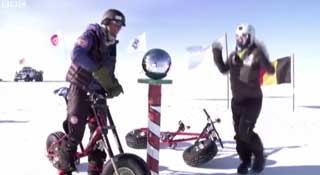 an adventurer as well as a moderator of popular BBC children's show Blue Peter, went to Pole on an interesting 500-mile ski/kite/bike trip. Her bicycle had been designed with assistance from Doug Stoup, who previously experimented with his own two-wheeler around Patriot Hills while contemplating a ride to Pole (archived BBC News article about the bicycle design). The small-tired (!) bike weighed 40 pounds and towed a 180 lb sled. She was accompanied by Niklas Norman, a Norwegian guide, who has a similar bicycle, as well as a media crew. Their trip was based from Novo...they flew there on 24 December, and were flown to their starting point at 83°S on 3 January. Their course and track paralleled the South Pole race with support from the same Arctic Trucks crew. Here is her blog archive from the BBC. As of 9 January they were nearing 86°S...and they reached Pole on the 22nd. Here's a 22 January BBC News article with video. The photo at right is a clip from this video. an adventurer as well as a moderator of popular BBC children's show Blue Peter, went to Pole on an interesting 500-mile ski/kite/bike trip. Her bicycle had been designed with assistance from Doug Stoup, who previously experimented with his own two-wheeler around Patriot Hills while contemplating a ride to Pole (archived BBC News article about the bicycle design). The small-tired (!) bike weighed 40 pounds and towed a 180 lb sled. She was accompanied by Niklas Norman, a Norwegian guide, who has a similar bicycle, as well as a media crew. Their trip was based from Novo...they flew there on 24 December, and were flown to their starting point at 83°S on 3 January. Their course and track paralleled the South Pole race with support from the same Arctic Trucks crew. Here is her blog archive from the BBC. As of 9 January they were nearing 86°S...and they reached Pole on the 22nd. Here's a 22 January BBC News article with video. The photo at right is a clip from this video.
- Other longer and unique routes:
-
- Acciona Antártica (archive site)
- are four men from Spain: Ramón Larramendi, with Javier Selva, and Ignacio Oficialdegui, led by Juan Pablo Albar. They did a 1900-mile crossing from Novo to Union Glacier via Pole using a five-runner "Polar Catamaran" sled--a concept that was successfully tested in the Spanish Transantarctic Expedition (Tierras Polares) of 2005-06. The sled equipped with tents and solar panels was pulled by kites of up to 80m²...they were hoping that they would find the right winds! As of 7 December they were in Cape Town awaiting the flight to Novo; they set out on 8 December and reached Pole on 2 January after a 190-mile non-stop run. Here also is a Greenland Windsled page about the trip.
- Aborted! Aloha Antarctica (archived site)
- called itself a "South Pole Skiing Expedition and Transantarctic Crossing"--Austin Wirth from Germany, and Dieter Staudinger from Austria (who were living near Toronto) planned a ski/kite venture starting in November 2011. They flew to Novo and then started from near SANAE on 10 November to on the way to Pole on what they said was the first expedition to use this route. They then planned return north to Hercules Inlet, covering a total distance of about 2200 miles, but they turned around after three days of very difficult ground travel conditions. With a sudden aircraft of advantage available, they, flew back to Novo from SANAE, got back to Cape Town on 3 December, and then returned home to Germany. The two men have traveled and trained extensively in the Arctic, and they first tried this South Pole trip in 2008-09 starting from Neumayer, but they ran out of kiting wind and aborted the trip when they didn't have enough supplies to reach their depot. Here is a 12 October news article from thespec.com (Ontario) about the expedition.
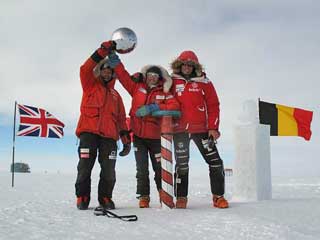 The Basque Team (TransAntartika 2011) (Spanish language site) The Basque Team (TransAntartika 2011) (Spanish language site)
- are Juan Vallejo, Mikel Zabalza, and Alberto Iñurrategi; they were on a long ski trip from Novo to Pole with a return to Union Glacier. On 16 November they were dropped off for their start 6 miles from Novo. A few days later they had to recover one of their sleds from a deep crevasse. They reached Pole on 29 December, after traveling the last 80 miles in 3 hours, and they lost their "unsupplied" status by having dinner at the tourist camp. They continued on to Hercules Inlet arriving on the 10th, well ahead of the 21 January deadline for completion of their venture. The photo at right is from their home page. Here's a 9 January 2012 Spanish news post with a hero shot of their arrival at Hercules Inlet.
- Antarctic ICE (archived site)
- was an unusual 6000km 2011-12 kite exploration of East Antarctica by Belgians Dixie Dansercoer (age 48) and Sam Deltour (age 25). Both have done extensive long-distance polar travel, and Dixie has traveled to Pole before. Using a variety of large kites, their trip was to start and end at Novo...from there they were to head counterclockwise to Pole and thence across some of the "inaccessible" sector toward the coast. They then were to circle back west, following the prevailing winds, and head back to Novo across the lightly traveled northern edge of the plateau. As of 2 November they were in Cape Town awaiting the flight to Novo (news24 report). They actually reached Novo a few days later and were flown to their starting point on 7 November. But ten days after their start, trapped in a "labyrinth of sastrugi," they were picked up and flown back to Novo for a second start (archived 16 November 2011 Reuters article). They waited out a storm and plotted their plans...and on 23 November they were flown out to a new starting point, from which they have been making much better progress with their large kites. They reached Pole on 22 December SP time, and left for on the evening of the 23rd. By 9 January they were near 78°S, roughly 2/3 of the way back to Novo. They reached their final position, 69º33'24"S, 93º36'20"E, on 2 February, having covered more than 5013 km. They were picked up and flown to Progress Station on 9 February, and when weather improved they returned to Novo a week later. They left their gear behind in anticipation of a future return. This archived 28 February 2012 Reuters article describes their successful journey completion.
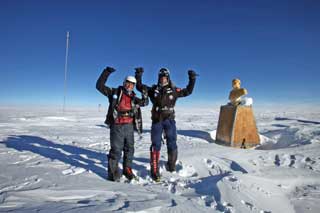 Sebastian Copeland and Eric McNair-Landry (a current page about Eric) Sebastian Copeland and Eric McNair-Landry (a current page about Eric)
- trained in Greenland in 2010 for what was to be an unusual 2011-12 unassisted kite-supported venture which they called the Antarctic Legacy Crossing. First, leaving in early November, they started directly from Novo on 6 November and headed first to the Pole of Inaccessibility (POI, 82°-06'S 54°-58'E)...to Pole...and then on to Union Glacier and Hercules Inlet. They had to head back north and replace a broken ski a few days after starting. As of 1 December they were at 76°S, still heading for the POI but a bit behind schedule. They reached the POI and visited the bust of Lenin on 28 December SP time (Sebastian's blog post with a photo of them in front of Lenin's bust--source of the photo at right), then headed for Pole. As of 7 January they'd had some good traveling days and were 50 miles from Pole as the skua flies, but Sebastian's sled had come open and he lost his sleeping bag and other gear. They reached Pole the next day, picked up some replacement gear, and headed for Hercules Inlet on the 12th. They finished the trip on the 24th after a long day of kiting about 230 km (Sebastian's blog post after they arrived at HI).
- Felicity Aston (archived site)
- of the UK, who led the December 2009-10 8-woman Kaspersky Lab Commonwealth Antarctic Expedition (archived site) to Pole, did a crossing, which she called the 2011-12 Kaspersky ONE Transantarctic Expedition. On 25 November she was flown from Union Glacier to her starting point at the base of the Leverett Glacier from where she was heading to Pole--the first skier to use the USAP traverse route. On 2 December she'd reached the top of the Leverett Glacier, and by 10 December she was at 87.5°S. Felicity arrived at Pole at about 0900 22 December SP time. At Pole she received a resupply and continued to Hercules Inlet, which she reached on 24 January, claiming a record of the first woman to ski alone across Antarctica. This archived page contains one-line brief status updates for each day of her trip. The 33-year-old has worked for BAS for several years, traveled in the Arctic, done the Marathon Des Sables, and participated in other similar ventures. This current version of her main web site has more information about Felicity's background and other expeditions.
- Pole to Pole Run (archived site)
- was exactly that...a multistage "run" from one Pole to the other organized by veteran Australian extreme distance runner (and ex-MP) Pat Farmer. The polar portions were led by Eric Philips of IceTrek fame. Their departure from the North Pole was scheduled for 2 April, but that was delayed a few days due to delays with the establishment of the annual Camp Barneo. From the North Pole, Greg's route headed to Canada and south through the Americas to Ushuaia, from where Pat was to fly to the ice on 29 December. The Antarctic portion of the trip was to be a 4-man team, also including adventure filmmakers Jose Naranjo and Clark Carter. They are starting from the Ronne ice shelf and be resupplied from caches. The team posted dispatches from the Arctic portion of the trip on the ExpeNews web site. At the end of October Pat was around Lima, Peru, and at the beginning of December he was closing in on PA. It looks like he flew south to Union Glacier about 31 January. He then headed for Pole via Hercules Inlet and Patriot Hills. And since he was running and not carrying/pulling anything, he was supported by a crew in one of those ALE Ford vans. Amazing to see videos of him running...not carrying anything, hundreds of miles away from a warm hut...oh, several of his videos are available on YouTube. He was held up a bit by mechanical problems with the van, but he reached Pole on 19 January.
- Pole2Pole (archived page with little information about the Antarctic trip)
- was another Pole-to-Pole venture.. Led by Johan Ernst Nilson of Sweden, accompanied by Harald Kippenes in the polar portions and Carl Robert Björkander on the the temperate leg. Johan and Harald left the North Pole around 8 April...their route originally included a crossing of Greenland, but they adjusted their route to cross more of Canada instead. As of the end of October the team was bicycling through Panama...a ways to go yet. At the end of November he was in central Ecuador...and opted to fly south to Antarctica from there...he said he'd return to finish the South America portion of his route afterward. He was flown to Novo, from where he set out for Pole on 2 December. As of 8 January he reported knee problems and a broken rib...and another week to go to reach Pole. Which he finally reached on the 20th.
- Shorter ventures and "last degree" trips:
-
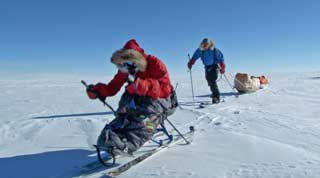 The Push (Facebook page about the venture and a 2019 documentary film about it) The Push (Facebook page about the venture and a 2019 documentary film about it)
- was an unusual venture originally planned by two athletes, California and Lake Tahoe natives John Davis and Grant Korgan, who are partially paralyzed. They planned a "last 100 mile" trip to Pole using custom-made Sit Skis; here is a September 2011 ESPN article about their expedition and the development of the unique skis that they will use. John had to drop out because of a training accident in Argentina; Grant is being guided by experienced Pole traveler/guide Doug Stoup and fellow Arctic/Antarctic guide Tal Fletcher, who is making his first trip to Pole; there also was a 4-man film crew. The first week in December they were training in Fairbanks (archived 10 December Fairbanks Daily News-Miner feature). They were flown from Union Glacier to their starting point on 7 January...and reached Pole on the 18th. For the final bit of the journey, Grant got up on regular skis and was supported by his companions as they reached the Pole...where Grant was met by his wife Shawna, who had flown in for the occasion as a surprise. The photo at right is from the Facebook page.
- Børge Ousland (archived page)
- with Bengt Egil Romo guided about 10 people on a last degree trip scheduled to arrive at Pole for the centennial of Amundsen's arrival. This the "Jubilee Last Degree" portion of the Jubilee expedition...the folks had gathered in PA on 1 December before flying to Union Glacier. They were dropped off at their starting point on 6 December, and reached Pole on the morning of the 14th just in time for the ceremonies.
- The Humpty Dumpty Foundation (blog archive)
- of Australia was being supported by a last degree venture guided by Australian mountaineer Damien Gildea, leading Kim Loane, Grant Bambach, Cath Murray, and Rob Clarke. The trek is raising money to assist sick children. They left Sydney for PA on 1 January, were flown to Union Glacier on the 6th, and were then flown to their start point at 89°S on 9 January.
- One Call Wintercamp (archived Norwegian language site)
- was a Norwegian group of 3 women and 3 men who planned to complete a kiting journey from 88°S 30°W in time to celebrate the Amundsen centennial on 14 December. They were selected by the One Call mobile phone company after a competition involving more than 4000 applicants. The team was flown from Union Glacier to their starting point on 30 November. But they completed only about half of the planned distance before they ran short of wind and supplies, so they were flown to Pole on 12 December in time for the ceremony on the 14th, they then were flown back to Union Glacier the next day.
- David Hempleman-Adams
- led nine others on a 97-nautical-mile trip to Pole from the southernmost point reached by Shackleton in January 1909. Based out of Union Glacier, the group included his 16-year-old daughter Amelia (BBC News article) (her web site/blog archive), Julian Evans, and Hazel Richards (5 January Stroud, England Gazette article). They left the UK on 18 November, and were flown from Union Glacier to their starting point on 27 November (Huffington Post article), and reached Pole early Saturday morning 10 December...and didn't stay around for the festivities...they were headed back to Union Glacier and PA that same day.
- Neal Laughton (archived page)
- the British adventurer and successful entrepreneur, was leading a group on a 100-mile trip to Pole in January, timed to coincide with the Scott centenary. Members of his group included James Balfour and Jon Beswick (10 November 2011 Bournemoth Daily Echo article). They reached Pole on 17 January, in time for a commemorative cricket match (17 January BBC News article) in which the Brits beat the science team.
- Other last degree expeditions
- included one sponsored by ANI/ALE guided by Eric Larsen, a several trips run by
Polarexplorers, one of which included Wendy Booker, and a trip from Adventure Consultants.
- Eric Philips
- According to his archived web site chronology...before he guided Pat Farmer's trip to Pole, he escorted a group of 11 Chinese to Pole--they were to fly from Novo to the base camp 14 miles from Pole, and travel to the station from there.
- What didn't happen at least in 2011-12...announced but with no updates unless noted:
-
- Alastair Humphreys
- from England had previously announced a round-trip venture to Pole along with fellow Brit Ben Saunders. This was originally planned for 2011-12, but was rescheduled for the 2012-13 season (that didn't happen either). Ben attempted the North Pole in 2010 but had to give up early when one of his fuel containers broke and contaminated most of his food.
- the British Antarctic Expedition 2011 (archived site)
- was a 5-person team consisting of Duncan Cameron, along with Anna Wakefield, Claire Marritt, Alex Toseland and Carl Alvey. Goals--Anna and Claire would have been the first British women to cross the continent, Claire would have been the youngest person, and Alex the first epilepsy sufferer. Oh, Duncan and Claire planned to get married at Pole (not exactly a "first") They planned another interesting route--a kite-assisted unsupported trip starting at the base of the Axel Heiberg Glacier, following Amundsen's route to Pole, and then proceeding to Hercules Inlet. This was announced for the 2011-12 season, but there were no updates.
- Cancelled! polarice (archived page)
- is a 4-man British team led by Mike Dann, along with Tim Tottenham, Simon Edmundson and Paddy Scott. They had been training in Greenland for what they called "the longest unsupported transantarctic journey ever undertaken"--a kite-assisted trip starting at Novo and proceeding to the Pole of Inaccessibility, the South Pole, and a finish on the Bellingshausen Sea, originally scheduled for 2010-11 but now put off indefinitely. Here's their blog, which only addresses the 2010-11 cancellation, and their current website only addresses their 2013 Greenland crossing.
- Cancelled! 2012 Inspire (archived site)
- was a project including 3 British athletes--Olympian Derek Redmond, Paralympian Marc Woods and Special Olympics athlete Declan Kerry...along with Rosie Stancer, great niece of the late Queen Elizabeth the Queen Mother, with manager/guide Tim Moss. They planned to ski to Pole unsupported starting in mid-December but had to cancel due to lack of funding, per this archived blog post. 51-year-old Stacey now proposes a 1913 solo trip to the North Pole (archived 15 November 2011 Telegraph article). Marc ended up as a participant in the Race to the South Pole.
- Nabil al Busaidi ("Nabs") (archived site)
- –an Omani adventurer who has already summited Vinson (archived blog from that January 2010 climb, walked to the north magnetic pole and rowed across the Atlantic, wanted to be the first Arab to walk to Pole, starting in mid-November 2011. There is not much on his web site or blog, although although his blog indicated he was having continuing ankle issues as of late 2011. And...apparently his ankle issues occurred during a March-April 2010 Everest summit attempt when both ankles were shattered after a fall at 6,200 meters...this and other of his life stories were published in the 2012 book Those who Inspire featuring the life stories of eminent Omanis. The excerpt about Nabil is here; the full book can be read on this site. His planned Pole trip was announced in a archived 2 October 2011 article in the Oman Observer. More recently, Nabil proposed, on his newer website, a 2018-19 trek from Hercules Inlet to Pole which never happened.
- Antarctic Challenge 2009-2012
- was to be an interesting planned centenary venture, where 5 teams of 5 (including experienced guides and young people) will start at 84°S from 5 points (roughly grid north, east, southeast, south and west) and travel 500 miles to Pole. Among other things, the group is commemorating the late Norman Vaughan, a member of Byrd's first expedition in 1928-30. Perhaps the best known of the ten leaders was Sarah McNair-Landry (archived site)...but note that the website news for the venture, which was originally titled "Antarctic Challenge 2009-2010, has not been updated since June 2010.
|
